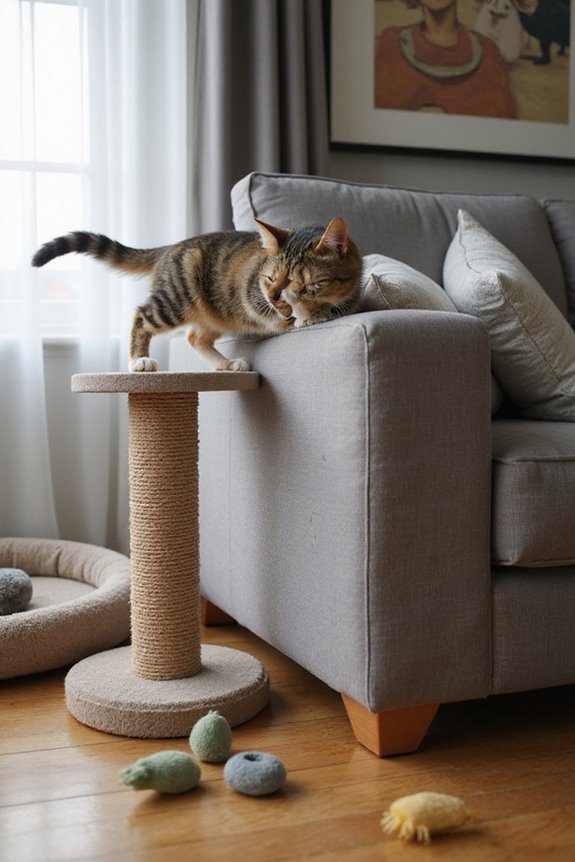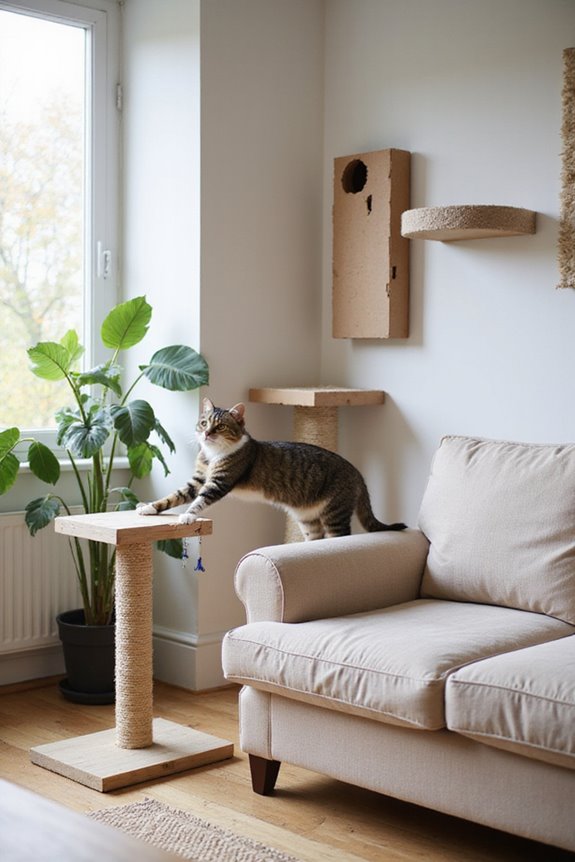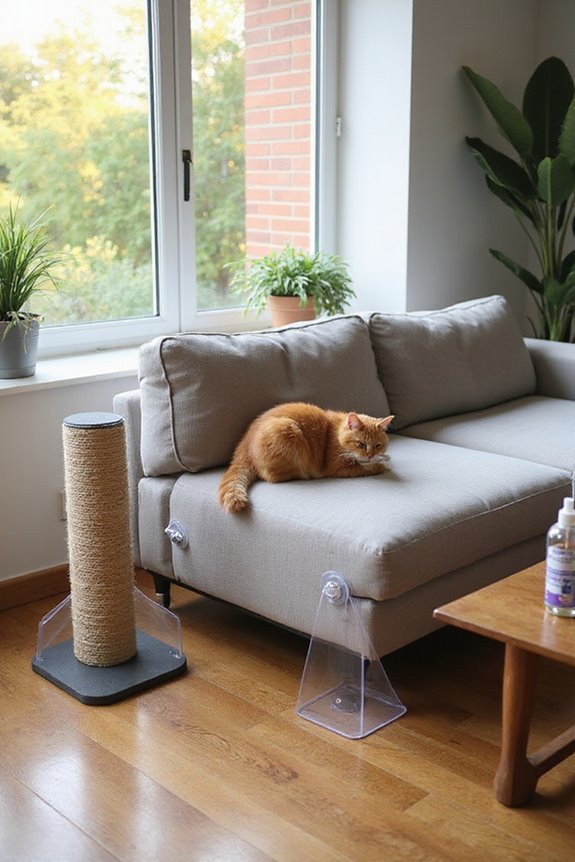To stop your cat from scratching furniture, start by understanding their instincts! They love to scratch for territory and fun. So, why not provide a sturdy scratching post? You’ll want to experiment with materials like sisal or cardboard, and place it near their favorite spots. Plus, try using adhesive tapes or repellent sprays on furniture. Don’t forget to trim those claws regularly—they’ll thank you for it! Curious about more tricks? There’s plenty more to explore!
Key Takeaways
- Provide appropriate scratching posts made from various materials like sisal or cardboard to satisfy your cat’s instinct to scratch.
- Apply deterrent products like adhesive tapes, vinyl guards, or scratch deterrent sprays on targeted furniture areas.
- Regularly trim your cat’s claws every two to four weeks to minimize damage to furniture.
- Create homemade repellent sprays using essential oils or vinegar to deter cats from scratching furniture.
- Place scratching posts near favorite furniture or resting spots to encourage your cat to use them instead.
Understanding Why Cats Scratch

Understanding why cats scratch can feel like unraveling a mystery, right? Those little furballs are driven by their innate feline instincts. Scratching reasons include marking territory and providing sensory stimulation. It’s a natural urge for them!
You might notice your cat scratching more when there are kids around or during nighttime playtime. Ever seen them get a bit stressed? Scratching can be a great stress relief, too!
And let’s be honest: when cats don’t get enough play, they can become frustrated and scratch more. So, keeping their environment engaging is key! Have you thought about how your cat’s personality plays into this? Charming, playful cats might scratch just for fun! It’s all part of their quirky world! Additionally, providing them with comfortable cat beds can help create a cozy space where they feel secure and less inclined to scratch furniture.
Providing Suitable Alternatives

If you’re tired of seeing your cat use your furniture as a scratching post, you’re not alone! Providing suitable alternatives can turn that behavior around. Start by exploring various scratching post materials like sisal rope, carpet, or cardboard. Cats have their favorites—what’s your feline fancy?
Next, consider the post height and stability. A tall post lets them stretch and play without tipping over. You wouldn’t want your cat scared off, right? Additionally, incorporating decorative pillows into your home can enhance comfort and style, making your space more inviting for both you and your pets.
Also, place these posts near your cat’s favorite spots or furniture they like to scratch. This encourages them to use the post instead of the couch. If you have multiple cats, be sure to offer more than one post to keep things friendly!
Effective Use of Deterrents

How can you keep your furniture scratch-free without losing your sanity? Using effective deterrents is your secret weapon! There are several deterrent types, like adhesive tapes and vinyl guards, that make surfaces unwelcoming for claws. Want something simple? Stick-on options are easy to fit and blend well with your furniture.
Don’t forget the nifty scratch deterrent sprays; they can help, though they might not be as strong as a physical barrier. Think about product placement too—focus on the areas your cat targets most. Remember, these products wear out over time, so check and replace them regularly! Keeping your furniture safe can be a fun challenge! Why not turn it into a puzzle? Additionally, consider incorporating high-quality materials in your decor to enhance durability and comfort in your home.
Regularly Trimming and Maintaining Claws

Keeping your cat’s claws in check is not just about aesthetics—it’s essential for your furniture and your feline’s well-being! Regular claw care makes a huge difference. Trimming not only shortens those scratchy claws, but it can also prevent them from curling into painful paw pads. Isn’t that a relief?
For low-activity kitties, every four weeks is great, while more active cats might need nail maintenance every two weeks. Got the right tools? Specialized nail clippers are your best friends! These can help make trimming easier and less stressful for both of you. Plus, a regular routine helps condition your cat to enjoy nail care. Who knew claw care could be so simple and beneficial? Let’s keep those claws—and your furniture—happy!
Creating Homemade Repellent Sprays

While you might think keeping your cat from scratching furniture is a challenging task, making homemade repellent sprays can be a fun and effective way to tackle the issue! Have you ever tried essential oil blends? Mixing lemon essential oil with rosemary can create a potent deterrent. Just add a bit of distilled water and vegetable glycerin for a smooth texture!
Or how about vinegar mixtures? Combining white vinegar with lemon juice offers a pungent smell that’ll make your cat think twice. You can even use rosemary herbs in your sprays!
With a few simple ingredients, you can whip up sprays that smell great to you but are a no-go for your feline friend. Ready to give it a shot? Let’s keep that furniture safe!
Covering and Shielding Your Furniture
So, you’ve tried those homemade repellent sprays, and now you’re looking for some extra protection for your furniture? Furniture covers are a fantastic option! They can protect upholstery and wood, and some are specifically designed to fend off scratching. Have you considered using protective tape? Cat deterrent tape is super easy to apply and won’t damage your furniture.
Vinyl guards can also be a clever addition; they’re versatile and can stick to many surfaces. But don’t forget about your couch—products like Sofa Scratchers lay over fabric, giving your cat a designated spot for scratching! Mixing these strategies can provide both protection and style to your home. Isn’t that a win-win?
Offering Alternative Stimuli and Play
When you think about keeping your kitty happily occupied, alternative stimuli and play are game-changers! Why not offer some scratching posts made from rope or sisal? They’re stable and at least 32 inches tall—perfect for a good stretch! You can also place bark-covered logs or a variety of alternative materials near their favorite resting spots to redirect that scratching instinct.
Now, let’s talk toys! Interactive environments with dangling toys or catnip can keep them entertained and away from your furniture. Have you considered adding visual stimuli like bird-watching stations? Just think—your cat’s busy with toys and scratching posts, and your furniture stays safe! It’s a win-win, right? Keeping it fun and engaging is key!
Establishing a Multi-Post Strategy
Establishing a multi-post strategy can truly transform your home into a cat’s paradise! Have you thought about scratching post placement? You should position them near frequently used furniture and cozy spots like cat beds. This will encourage your feline friend to scratch where you want them to.
Now, let’s talk material preferences. Cats often favor different textures, so consider offering sisal rope, carpet, or even cardboard. By experimenting with these materials, you’ll discover what your cat loves best!
And don’t forget to have multiple posts, especially in a multi-cat household! This helps prevent any squabbles over territory. Isn’t it amazing how a few adjustments can make such a big difference? Your furniture will thank you!
Seeking Professional Guidance and Resources
Have you ever wondered how professional guidance could help you tackle your cat’s scratching habit? Seeking a veterinary consultation can be a game-changer! If your cat’s scratching is sudden or excessive, a vet can identify health issues or anxiety and suggest calming pheromone diffusers.
But wait—there’s more! Behaviorist support can dive deeper into your cat’s unique quirks. They’ll analyze behavior patterns and develop a tailored plan to redirect scratching to appropriate surfaces. Imagine turning that urge to scratch into a flair for using scratching posts!
Don’t forget, educational workshops and online resources can also provide you with hands-on tips and strategies. Who knew fixing furniture damage could be fun, right?
Frequently Asked Questions
What Are the Signs of Stress-Related Scratching in Cats?
You’re likely noticing stress indicators in your cat if they scratch excessively. Behavioral changes like hiding, over-grooming, vocalizing more, or eliminating outside the litter box all point to increased stress levels needing attention.
How Do I Introduce a Scratching Post to My Cat?
To successfully introduce a scratching post, position it prominently in your pet’s preferred place. Encourage cat behavior with treats, toys, and catnip, making it a tempting territory for playful paws to explore and enjoy.
Will Declawing My Cat Stop Furniture Scratching?
Declawing won’t completely stop your cat’s scratching; many still attempt it. Instead, consider declawing alternatives like offering scratching posts made of various materials. This encourages appropriate scratching and helps protect your furniture without causing harm.
Can I Train My Cat Not to Scratch?
Yes, you can train your cat not to scratch by using positive reinforcement and consistent behavior modification techniques. Reward them for using appropriate surfaces, and avoid punishment to encourage good habits while redirecting their natural instincts.
How Often Should I Replace Scratching Posts?
Surprisingly, your cat won’t always let you know when it’s time to replace that scratching post. Generally, check every 6-12 months, as the scratching post lifespan varies with wear and your cat’s behavior changes.



